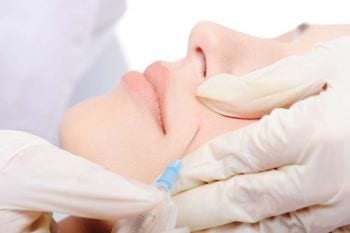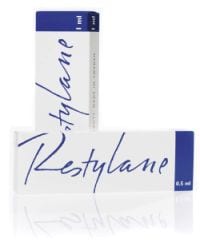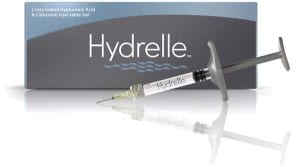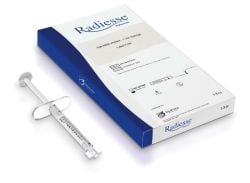
Advances in medicine and lifestyle changes have created a population of patients who live longer and lead increasingly active lives. This healthier, aging population has shown a desire to maintain and restore a more youthful outward physical appearance.
Concomitantly, there has been a shift in the field of aesthetics toward less invasive procedures. Surveys performed by the American Society of Plastic Surgeons have demonstrated a 99% increase in minimally invasive cosmetic procedures and a 20% decrease in surgical cosmetic surgeries over the past decade. Soft-tissue augmentation has been at the forefront of this proliferation, increasing more than 160% during that time.
With decreased recovery time and increased prevalence, the social stigma associated with cosmetic interventions has become more favorable, further fueling patients’ interest in soft-tissue augmentation.
A SHIFT IN FOCUS
Whereas the changes in the aging face were previously thought to be primarily a vertical descent of tissues with correction achieved via lifting surgeries, there has been a greater appreciation of the changes that occur in anterior projection of the face.

Restylane has the longest history of approved cosmetic use of the currently available fillers.
Anatomical studies have revealed the presence of multiple discrete compartments of subcutaneous facial fat occurring in both superficial and deep subcutaneous planes. With age, these compartments show different degrees of atrophy, thereby altering the facial shape and contours.
Due to loss of elasticity, the aging skin envelope is less able to accommodate these changes in subcutaneous volume, thus sagging and creating rhytids and folds. Changes in the underlying facial skeleton also alter the platform on which these soft tissues rest.
Just as changes occurring at multiple tissue planes contribute to the aging face, so must correction come from addressing these changes at different planes. This realization underlies the shift in paradigm that has occurred in the field of soft-tissue augmentation.
If you are injecting in the same manner that you did 3 or 4 years ago, you are unlikely to obtain optimal results. Traditionally, soft-tissue augmentation focused on correction of individual rhytids and folds via direct injection in a dermal plane.
The emphasis has shifted toward using one or more injectable products to correct changes in the soft tissues at multiple tissue planes, often deeper than was historically done. Traditional fillers relied on physical expansion of tissues related to the presence of the product itself. Currently, there are products that are biostimulatory, eliciting native collagen production to produce longer-lasting volumetric correction.
FDA-APPROVED FILLERS
The past decade has seen an expansion of the products available for soft-tissue augmentation. A field that was previously limited to using a small repertoire of bovine-derived collagen products or controversial off-label use of liquid injectable silicone now consists of a variety of products allowing much broader applications.
1) Hyaluronic acid
The Hyaluronic acid (HA) fillers are some of the most studied, frequently used, and versatile products available. Although in its naturally occurring form in the dermis, HA has a half-life of only 1 to 2 days, it is cross-linked in fillers to resist degradation.
Restylane (Medicis Aesthetics Inc, Scottsdale, Ariz) has the longest history of approved cosmetic use of the currently available fillers—the FDA approved it in 2003.

Hydrelle was the first FDA-approved Hyaluronic acidbased filler to include lidocaine.
Perlane, also from Medicis and approved in 2007, is a more viscous filler that differs from Restylane by its larger particle size, thus requiring a 27-gauge needle for injection rather than the 30-gauge needle typically used for Restylane.
Juvéderm (Allergan Inc, Irvine, Calif) is another HA product that is a smooth gel, as opposed to the gel-particle suspension in Restylane and Perlane. It is supplied as Juvéderm Ultra and a more highly cross-linked Juvéderm Ultra Plus, and they are injected via 30- and 27-gauge needles, respectively.
The authors have found that the Restylane family of products is firmer and provides a more precise and sculpted result, whereas the Juvéderm family is smoother and provides a broader augmentation.
Restylane-L, Perlane-L, Juvéderm Ultra-XC, and Juvéderm Ultra Plus-XC differ only by the addition of 0.3% lidocaine to improve patient comfort. Results persist for approximately 6 months, although in some locations with minimal muscle movement, such as the nose and tear troughs, a longer duration is expected.
Other HA fillers include Hydrelle, Prevelle Silk, and Puragen. Hydrelle (Anika Therapeutics Inc, Bedford, Mass), which was initially marketed as Cosmetic Tissue Augmentation Product and then as Elevess, was the first FDA-approved HA product to include lidocaine.
Prevelle Silk (Mentor Corp, Santa Barbara, Calif), which also contains lidocaine, has a HA concentration of only 5.5 mg/mL and provides correction lasting 2 to 3 months.
Puragen (also from Mentor) has a small particle size, which reportedly improves flow characteristics and is reported to persist for 9 to 12 months.
2) Calcium hydroxylapatite (Radiesse)
Radiesse (BioForm Medical Inc, San Mateo, Calif) is a viscous filler consisting of calcium hydroxylapatite (CaHA) microspheres suspended in an aqueous gel vehicle. As the gel vehicle dissolves, a matrix of CaHA remains, inducing host collagen production before being broken down into calcium and phosphate and eliminated by normal metabolic processes.
Thus, Radiesse is a combination filling and biostimulatory agent, with initial volume correction occurring due to the presence of CaHA microspheres, and more persistent correction due to native collagen production. Results can last 9 to 18 months.
One or 2% lidocaine with or without epinephrine at a volume of 0.05 to 0.3 mL per 1.5-mL syringe of Radiesse can be added at the time of injection, using an accessory kit consisting of a 3-mL syringe and a double female leur lock connector to increase patient comfort.

Radiesse, from BioForm Medical, is a combination filling and biostimulatory agent.
3) Poly-L-lactic acid (Sculptra)
Initially approved by the FDA in 2004 to correct signs of HIV-associated lipoatrophy, Sculptra (sanofi-aventis US, Bridgewater, NJ) received approval for “correction of shallow to deep nasolabial fold contour deficiencies and other facial wrinkles” in 2009.
With the recent appreciation for its role of atrophy of facial fat compartments in the aging face, poly-L-lactic acid (PLLA) has emerged as an agent well suited for volumizing and correcting resulting contour deficiencies.
Sculptra consists of lactic acid polymers supplied in a freeze-dried state, which is reconstituted prior to injection. Although the package insert recommends reconstitution with 5 mL of sterile water, larger volumes are often used and reconstitution is often performed with sterile saline, bacteriostatic saline, and/or lidocaine with or without epinephrine.
The authors favor reconstitution 3 to 5 days prior to injection with 6 to 7 mL of bacteriostatic saline, with the addition of 2 mL of 1% lidocaine with 1:100,000 epinephrine immediately prior to injection.
Upon injection, the reconstitution liquid is absorbed over 1 to 4 days, leaving PLLA particles that induce a fibrotic response and subsequent collagen production over 1 to 2 months.
Two or three injection sessions of one to two vials spaced 1 to 2 months apart are generally required to achieve the desired level of augmentation, although this varies based on the site and amount of volume desired.
Injection is performed with a 25-gauge needle in the subcutaneous or supraperiosteal/inframuscular planes in a fine lattice via cross-hatching, fanning, or multiple linear threads to provide a homogenous distribution of PLLA (to decrease the risk of nodule formation). An exception is in the temporal fossa, where submuscular bolus injections can be performed. The treatment sites are massaged immediately after injection, and the patient is instructed to massage five times daily for 5 minutes for 5 days.
4) Polymethylmethacrylate
Currently, ArteFill (Suneva Medical Inc, San Diego) is the only permanent synthetic injectable soft-tissue augmentation agent approved for cosmetic use by the FDA, obtaining approval for augmentation of the nasolabial folds in 2006.
ArteFill consists of polymethylmethacrylate (PMMA) microspheres suspended in an aqueous gel suspension that includes 3.5% bovine collagen. Due to the presence of bovine collagen, an intradermal skin test to identify patients with a hypersensitivity reaction is performed 4 weeks prior to injection.
ArteFill is injected via 26- or 27-gauge needle in the deep reticular dermis or dermal-subcutaneous junction. One to 3 months after injection, the vehicle is absorbed, leaving PMMA microspheres, which are encapsulated by host collagen and persist indefinitely. Overcorrection must be avoided, and gradual volumization should be achieved over multiple injection sessions spaced several months apart.
SITES FOR TREATMENT AND TECHNIQUE TIPS
As understanding of facial soft-tissue anatomy and its changes with aging have evolved, so have the ways in which fillers are utilized. Soft-tissue augmentation is being carried out in a much more comprehensive nature than was previously done with synthetic fillers, involving volume correction in several planes and sites simultaneously to create a balanced rejuvenation.
1) Malar and submalar cheeks
Volume depletion in the malar and submalar cheeks has emerged as a central component of facial aging. A deep medial fat compartment, adjacent to the nose and deep to the superficial subcutaneous fat, has been defined. The midface has been found to be relatively stable in vertical position, but soft-tissue atrophy—in concert with retrusion of the underlying maxilla—results in a loss of anterior projection and subsequent pseudoptosis due to a redundant skin envelope.

Allergan’s popular HA-based filler is a smooth gel, as opposed to the gel-particle suspension of Restylane.
Revolumization of the deep medial fat compartment in a submuscular/supraperiosteal plane can restore a more youthful and rounded anterior projection of the midface, while secondarily softening the nasolabial fold and tear trough. The superficial cheek fat is divided into the medial, middle, and lateral cheek compartments, all of which can be augmented in the superficial and midsubcutaneous planes.
PLLA, CaHA, or the heartier HA fillers such as Perlane or Juvéderm Ultra Plus may be placed using cross-hatching or fanning techniques. Care must be taken to avoid the infraorbital foramen and its associated neurovascular structures.
2) Tear troughs
These complex anatomical structures manifest as a concavity along the medial cheek-inferior eyelid junction.
Tear troughs are formed by the sharp transition from thin, textured, and pigmented inferior eyelid skin to the thicker, less pigmented, and smoother cheek skin; shadowing from protrusion of the bulbar fat pads; and depression of the inferior eyelid superior to the lid-cheek junction.
Injections should be performed in a supraperiosteal/subsorbicularis plane to avoid visible or palpable irregularities in this area of thin tissues. The HA fillers are most commonly used, although CaHA may also be utilized. Linear threading or fanning techniques may be used to place a homogenous plane of filler.
3) Temples
With age, the temporal fossa becomes concave and develops a skeletonized appearance due to decreased projection of the subcutaneous fat, temporalis muscle, and temporal bone. Here, injection is typically performed in a supraperiosteal plane using either course threads in a fanning or cross-hatching pattern or via boluses throughout the area of desired correction.
PLLA, CaHA, or more viscous HA products such as Perlane or Juvéderm Ultra Plus are typically utilized in the temples. Massage immediately after injection can ensure an even and smooth distribution.
4) Brows
With age anterior projection of the brows decreases and brow shape changes with mild elevation medially, creating “pseudoptosis” laterally.
HA, CaHA, or PLLA can be used to restore anterior projection and elevation of the brows. The preferred plane of injection is submuscular/supraperiosteal, predominantly in the lateral third of the brow superior to the orbital rim via linear threading and fanning.
Blending to the central brow may be performed, with care to avoid the supraorbital and supratrochlear neurovascular bundles. Manual molding can be performed to ensure proper placement.
Injection can also be continued in the supraperiosteal plane around the lateral orbital rim and zygoma. Less viscous HA fillers can be used to fill the crow’s feet and periorbital rhytids via intradermal serial puncture injections using a 32-gauge needle.
5) Lateral cheeks
Injection of the preauricular cheek produces a more youthful rounded contour to the lateral face, providing tightening of the skin envelope as far medially as the nasolabial folds and marionette lines.
Injections should be performed in the superficial subcutaneous fat to avoid violation of the underlying parotid fascia. HA, CaHA, and PLLA can be utilized in a fanning or cross-hatching pattern placed via linear threads.
6) Mandible and chin
With age, the smooth convexity of the mandible is lost due to changes in the underlying bone and soft tissues, resulting in a flatter jawline interrupted by the jowls and associated prejowl sulcus.
Fillers including HA, CaHA, and PLLA can be used to provide a smoother, more youthful contour to the mandible. Injections in a supraperiosteal or subcutaneous plane anterior to the jowls correct the prejowl sulcus, and those along the posterior mandible in the subcutaneous plane further smooth the jawline. Posteriorly, deep injections must be avoided to prevent violation of the underlying parotid gland.
Injection in a submentalis plane on the chin can improve anterior projection, and serial injections in the mid-dermis with HA or CaHA can be used to correct the superficial mentolabial crease.
Marionette lines can also be injected via linear threading, fanning, or cross-hatching in the superficial subcutaneous plane.
7) Nasolabial folds
Historically, the nasolabial folds have been thought to result from gravitational descent of midfacial soft tissues and traction of the skin by the lip elevators.
Nasolabial folds were typically addressed via direct injection with a filler. More recently, the role of midfacial volume loss in the formation of the nasolabial folds has been appreciated. The nasolabial fat persists with aging, which, when juxtaposed to the loss of fat in the medial and middle cheek fat compartments, results in accentuation of the nasolabial folds. Thus, augmentation of the midface via injection of the deep medial fat pad and medial fat pad with a product such as PLLA or CaHA in the submuscular and subcutaneous planes “reinflates” the skin envelope, thereby smoothening the transition to the nasolabial fat compartment and softening the nasolabial fold via vertical traction.
In combination with direct subcutaneous and dermal-subcutaneous injections along the medial border of the nasolabial fold with a robust product such as CaHA, Perlane, or Juvéderm Ultra Plus, this provides a balanced correction.
At the superior aspect of the nasolabial fold, a small bolus supraperiosteal injection in the pyriform aperture softens the nasolabial fold and provides a more youthful anterior projection of the alar base and superior rotation of the nasal tip.
For more superficial “etched” lines along the nasolabial folds, serial puncture injections in the mid-dermis with a low-viscosity HA product with a 32-gauge needle can help provide a smooth skin surface.
8) Nose
Soft-tissue augmentation of the nose can correct asymmetries and unwanted contours related to genetics, prior surgery, or injury. HA products are preferred for nasal injection, although CaHA has also been used with success. Only small volumes are used in a submuscular, supraperiosteal, or supraperichondrial plane along the nasal dorsum, radix, or supratip. Manual molding is performed after injection to ensure an even and smooth distribution of filler.
Injection of the nasolabial angle, at the junction of the nasal columella and upper cutaneous lip, with a small bolus at the dermal-subcutaneous junction can mask ptosis of the nasal tip by widening the nasolabial angle. Correction can be long-lasting on the nose, with HA potentially persisting more than 1 year and CaHA for 2 years.
9) Lips
The lips are both one of the most common areas addressed by fillers and one of the most complex 3D structures. With age, not only is their 2D shape altered, but they also lose anterior projection.
Increased anterior projection, prominent philtral columns and a distinct white roll along the vermillion border, increased eversion of the vermillion, and a more gradual slope between the oral commissures and Cupid’s bow characterize a youthful lip.
An HA filler can be injected along the white roll to define the vermillion-cutaneous junction and help diminish radiating lip lines, which can be further softened via serial puncture in the mid-dermis with an HA product using a 32-gauge needle. Subcutaneous injection of the wet-dry junction of the pink lip is performed with care to accentuate rather than distort the lip’s natural contours.
The inferior lip is typically characterized by a subtle central depression framed by two subtle mounds of fullness just lateral to midline. The superior lip often consists of a central tubercle at midline and small mounds just medial to the oral commissures.
Respecting the natural shape of a patient’s lip rather than homogenously filling the lips will provide a natural-appearing enhancement. The upper lip should also not be filled out of proportion to the lower lip; the lower lip is typically larger than the upper lip, creating a desirable “pouty” appearance. If the upper lip is disproportionately augmented, a “duck bill” appearance can result.
Filling of the philtral columns via linear threading at the dermal/subcutaneous junction and correction of the downturned corners of the mouth via fanning from an inferior injection in the dermal/subcutaneous plane can complete lip augmentation.
Brad T. Kovach, MD, is in private practice at Mohs & Cosmetic Dermatologic Surgery, Naples, Fla; Roberta Sengelmann, MD, is in private practice at Mohs & Cosmetic Dermatologic Surgery, Santa Barbara, Calif, and St Louis, and a clinical associate professor at the University of California, Irvine. They can be reached at [email protected].




